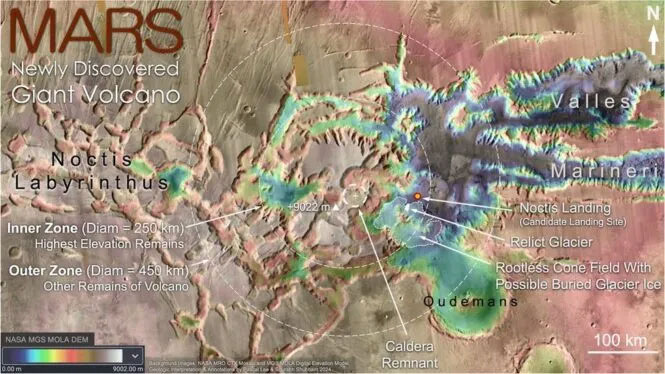The Dark Labyrinth: Where does Martian life hide?
The new discovery of a giant ancient volcano makes the Dark Labyrinth an attractive choice for life-hunting missions.
The Noctis Labyrinthus or Labyrinth of the Night - is located in the equatorial region of Mars, one of the celestial bodies that NASA and many other space agencies believe may have once existed.
In new research, a team of scientists led by planetary scientist Pascal Lee from the SETI Institute (Search for Extraterrestrial Intelligence Institute - USA) has discovered the incredible secret of the Dark Labyrinth. .

A giant volcano has just appeared in the middle of the Dark Maze - (Photo: Pascal Lee and colleagues).
That's when they followed the tracks of an ancient glacier and realized the remains of a giant, ancient volcano.
The volcano was so heavily eroded that scientists at first did not recognize it in remote sensing data. It has just been provisionally named Noctis Mons.
"This area of Mars is known to have many types of hydrated minerals spanning the history of Mars. The volcanic context that formed these minerals has long been suspected" - geologist planet Sourabh Shubham from the University of Maryland (USA) explains.
Analyzing more specifically, the research team realized that the size of the volcano was extremely large. It has a peak of more than 9,000 m and stretches over more than 250km.
Thus, Notics Mons becomes the 7th highest topographic feature on Mars , although far surpassing the highest inactive volcano on Earth (6,893 m).
In the central area, scientists have identified a collapsed crater that was once a hot lava lake.
Additionally, several flat peaks in the central area form arcs, outlining the volcanic cone, sloping down to the lava fields surrounding the geological mess.
Volcanic deposits also spread over an area of up to 5,000m 2 .
More interestingly, they discovered a large area containing blister-like mounds, a type of low-lying volcanic landform that can be created when lava flows over a surface. surface rich in water or ice.
Thus, glacial sediments may be present here, and may be evidence of a world of living creatures that once dominated the red planet.
Heat and ice interactions in this region in the past may also have helped create important minerals that supported early life, as may have happened on our planet.
Therefore, scientists believe that the Dark Labyrinth may also be a maze of life waiting for humanity to explore.
- The spy is able to escape
- Mysterious labyrinth under Rome
- How to hide the number and hide caller ID on iPhone and Android
- Tropical spiders can hide for 30 minutes underwater
- 830 million-year-old 'mummy' shows where Martian creatures hide
- Tip Hide professional Excel spreadsheets
- New explanation of the origin of dark matter
- Hide Taskbar 1.28.2 - Hide windows and taskbar -
- Japanese ship brought back to Earth 'dark matter' containing the germ of life?
- Finding shells on Mars
- Artificial intelligence only takes 5 seconds to detect a new crater on Mars
- 10 mysteries in the universe
 Announced 3 houses on the Moon and Mars
Announced 3 houses on the Moon and Mars Science proves: Mars also knows 'deflated'
Science proves: Mars also knows 'deflated' Elon Musk announced the price for a Mars trip was 11.6 billion VND, free of charge
Elon Musk announced the price for a Mars trip was 11.6 billion VND, free of charge NASA discovered strange 'gate' on Mars, is the hiding place found?
NASA discovered strange 'gate' on Mars, is the hiding place found?